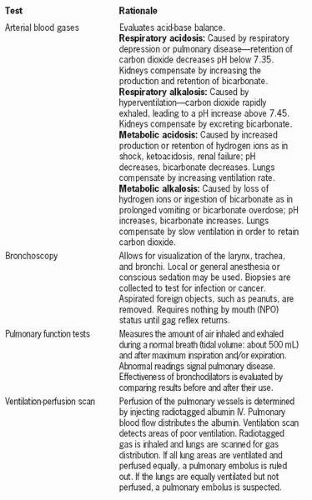Anatomy and Physiology of the Respiratory System
The functions of the respiratory system are to provide oxygen to cells during inhalation; to remove carbon dioxide, which is a byproduct of cell metabolism, during exhalation; and to help regulate serum pH. Oxygen is needed to produce adenosine triphosphate (ATP), which is a nucleic acid that powers cellular activity. Cellular activity produces carbon dioxide that must be removed to prevent a buildup of carbonic acid (carbon dioxide + water = carbonic acid) in the bloodstream, which would lower blood pH to life-threatening levels. Although the term respiration is frequently used to denote respiratory activity, ventilation and respiration are more precise descriptors. Ventilation means the movement of air and thus denotes inhalation and exhalation, whereas respiration denotes the exchange of oxygen and carbon dioxide between cells, the alveoli, and the environment.
The pulmonary system consists of the airways (nasal passages, mouth, nasopharynx, larynx, trachea), lungs (two lobes on the left, three on the right), diaphragm, and pulmonary blood vessels. Turbinates are tissue protrusions in each nostril that create air turbulence. Large pollutants, such as dust, are trapped by nasal hairs, whereas the tiny capillaries of the nares warm and humidify the air. Stimulation of nasal irritant receptors by triggers such as pollen activates the sneeze reflex and clears the nares. Insensible water loss of approximately 1 pint per day occurs as we provide humidity to the air we breathe. The frontal, maxillary, and ethmoid sinuses are air-filled spaces that provide resonance to the voice. The larynx contains the vocal cords. Aspiration is prevented by the epiglottis, a tissue flap that closes over the tracheal opening during swallowing.
The trachea branches into the right and left bronchus and then further divides 16 times, finally ending in terminal bronchioles. Mucus and cilia, which line the airway, trap and remove inspired foreign particles by an escalator motion. When the mucus reaches the pharynx, it is either swallowed or expectorated. If tracheal or large airway irritant sensors are triggered, the cough reflex is activated and the lower airways are cleared. The ability to clean and humidify the airway and prevent an environment in which bacteria can flourish is impaired by anything that damages the mucociliary system, such as dehydration, smoking, dry air, or by mouth breathing or a tracheostomy, which bypasses the nares.
 The ability to clean and humidify the airway and prevent an environment in which bacteria can flourish is impaired by anything that damages the mucociliary system.
The ability to clean and humidify the airway and prevent an environment in which bacteria can flourish is impaired by anything that damages the mucociliary system.There is a double-layered membrane that lines the inside of the thoracic cavity (parietal pleura) and the outside of the lungs (visceral pleura) so that the lungs slide up and down easily during inhalation and exhalation. A thin layer of serous fluid lubricates the pleura and reduces friction associated with ventilation. Accumulation of excess pleural fluid
is called pleural effusion and results in lung tissue compression and inadequate ventilation.
is called pleural effusion and results in lung tissue compression and inadequate ventilation.
 Accumulation of excess pleural fluid is called pleural effusion and results in lung tissue compression and inadequate ventilation.
Accumulation of excess pleural fluid is called pleural effusion and results in lung tissue compression and inadequate ventilation.The medulla oblongata in the lower brainstem contains “pacemaker” cells that stimulate autonomic ventilation. The phrenic nerve, which innervates the diaphragm and internal intercostal muscles, transmits neural impulses that trigger inhalation. Stimulation of the apneustic center in the pons triggers gasping ventilation when the higher respiratory center is damaged by trauma.
Stay updated, free articles. Join our Telegram channel

Full access? Get Clinical Tree




